In May, Iran suffered from several nationwide power outages, which contributed to a series of network disruptions throughout the month. According to Arash Karimbeigi, CEO of the major Iranian ISP Shatel, the power outages meant that mobile operators struggled to provide power for crucial communications infrastructure, including Base Transceiver Station (BTS) antennas.
This report makes use of data from Internet Outage Detection and Analysis (IODA), which is a project of the Center for Applied Internet Data Analysis (CAIDA), based at the University of California’s San Diego Supercomputer Center.

Overall Situation
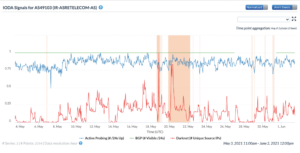
Based on IODA data from May 1 – 30, we observed reductions of traffic on multiple occasions, including such as May 4, 7, 13, 14, 21, and 28. Iranian officials have failed to provide any explanation for any of these disruptions besides citing the effects of nationwide power outages on mobile operators’ BTS antennas. However, a source working at one of Iran’s internet providers told Filterwatch that they were cut off from the internet for three hours on May 19 from 20:00 EDT until around 22:52 EDT. According to this trusted source, they were cut off from the Telecommunication Infrastructure Company (TIC) without any explanation from the TIC.
The source spoke with Filterwatch under condition of anonymity on May 19 2021, saying: “All of our links had problems. We did several traceroutes, all of them made their way successfully to the infrastructure [TIC] and there, we lost all packets.”
Regional Outages
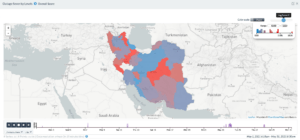
According to the IODA map, Chahar Mahall and Bakhtiari, South Khorasan, Kermanshah, Kerman, Alborz, Yazd, Ilam, Hamadan, and Qazvin had the most disruptions.

The IODA graph above shows disruptions in Chahar Mahall and Bakhtiari Province in May, with periods of heavy disruption highlighted. The red arrows indicate incidents where disruption was detected via both Active Probing and BGP methods, indicating likely disruption. The orange arrow indicates a period where disruption was detected via Active Probing, but where BGP data was unavailable. This means we cannot as confidently state that disruption was experienced.
We saw two visible drops on May 3rd 19:00 UTC and May 15th 22:00 UTC in the number of networks reachable through BGP, and according to the IODA outages data, on AS58224 (TCI) in Chahar Mahall and Bakhtiari. IODA also showed outages on AS58224 of TCI in South Khorasan.
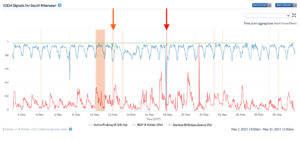
A graph showing disruptions in South Khorasan Province in May. The orange arrow highlights a period of potential minor disruption detected via BGP and Active Probing methods. The red arrow at 22:00 UTC on May 17 marks a brief period of major disruption, with BGP and Darknet scores falling to near zero, alongside a small BGP anomaly.
Provider Outages
According to the IODA data, five major internet providers were suffering from internet outages.
- AS41881 – Fanava, which is one of the main providers in Iran, had the most disruptions; this was confirmed by several Filterwatch sources who are using Fanava as their main link. This caused several outages in Tehran.
- AS50810 – Mobin Net, an internet service provider was almost completely disconnected from the internet on May 6 at around 05:00 UTC. This outage mainly affected users in Tehran province.
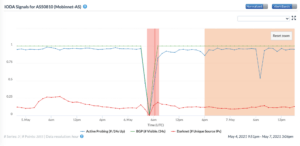
- AS44244 Iran Cell Service and Communication Company, a mobile data provider, experienced several disruptions and a drop in the number of networks reachable through BGP on May 11 at around 22:00 UTC. These disruptions affected users in Tehran and East Azarbaijan.
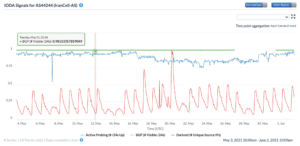
- AS16322 Pars Online PJS, an internet service provider experienced several disruptions including on May 7, 8 and 23, affecting users in Tehran. The cause of this disruption is unknown.
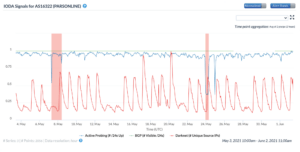
- AS49103 Asr-e Enteghal-e Dadeha Company, an internet service provider suffered from multiple source IP disruptions across the entire month, providing no explanation to its users. This affected users in Tehran.

